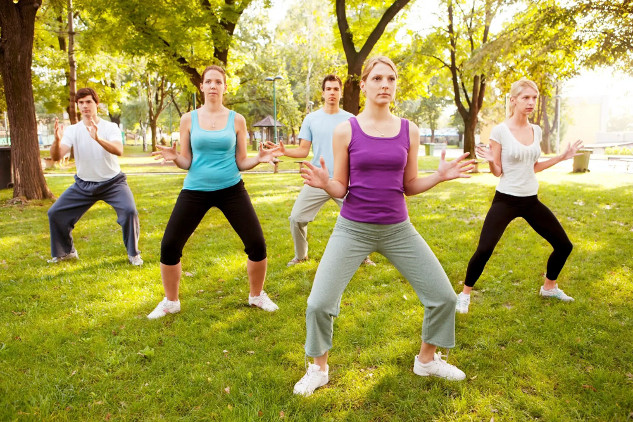
Are you seeking a gentle yet powerful practice that balances your body and mind? Look no further than Tai Chi. This ancient martial art, often called "meditation in motion," offers many benefits for beginners and experienced practitioners. This accompanying video covers Tai Chi for beginners, exploring its fundamentals, warming up exercises, and the flow of energy that can enhance your overall well-being.
Discovering the Essence of Tai Chi
Tai Chi Chuan, commonly known as Tai Chi, originated in China over 300 years ago. Originally developed as a martial art, Tai Chi has evolved into an "internal martial art" that prioritizes improving health and enhancing the mind-body connection. It combines relaxed and fluid movements with a calm, focused mental state.
Imagine performing gentle, flowing motions synchronizing with your breath, promoting peace and serenity within. Tai Chi offers just that, allowing you to experience the harmonious integration of body and mind.
The Peaceful Beginning: Tai Chi Fundamentals
Tai Chi classes for beginners typically commence with a traditional greeting, symbolizing self-control and peace. The instructor guides you through foundational movements that form the basis of this healing martial art.
One of the initial steps in Tai Chi is adopting a horse stance, which helps establish a connection to the earth. In this posture, you focus on your posture, sitting tall with rolled-back shoulders. The horse stance is akin to sitting on an imaginary horse, cultivating strength and stability in your legs.
With the horse stance as your foundation, you open up your waist, allowing your hands to move freely and gently tapping your front and back. A little secret lies in gently tapping your kidneys, as Traditional Chinese Medicine associates the kidneys with storing Qi (energy) and essence. By stimulating this area, you facilitate the flow and circulation of Qi throughout your practice.
Caring for Your Knees: A Crucial Aspect of Tai Chi
In Tai Chi, proper knee care ensures long-term practice without discomfort or injury. Tai Chi classes for beginners often include knee warm-up exercises to promote knee health and flexibility.
You start by bringing your feet together and performing circular motions with your knees. The key is gradually increasing the range of motion without causing pain. Caring for your knees establishes a solid foundation for the rest of your Tai Chi journey.
Additionally, Tai Chi incorporates pressure points in the back of the knee, which are significant for low back health and knee circulation. You enhance circulation and promote overall well-being by firmly pressing on these points.
Unleashing the Flow: Opening Your Neck and Chest
Posture plays a crucial role in Tai Chi; an integral part of that is opening up the muscles in your neck and chest. Interlocking your fingers behind you and rolling your shoulders back and down creates space and openness in your chest.
With your chin slightly tucked in, you rotate your neck in both directions, exploring its full range of motion. These neck movements contribute to improved posture and provide numerous benefits, including enhanced balance, blood pressure regulation, and posture correction, which may be why you embarked on your Tai Chi journey.
Flowing with the Hips: Building Stability and Mobility
Your hips are essential to Tai Chi movements, as they provide stability and mobility throughout the practice. Tai Chi classes for beginners often include exercises to warm up and engage the hip joints.
Shifting your weight and performing circular movements with your hips create fluidity and looseness in the ball and socket joint. These exercises increase awareness of the hip area and prepare your body for graceful movements.
Energy in Motion: Visualizing the Flow of Life Force
Tai Chi is not just about physical movements; it is a practice that involves the cultivation and circulation of energy within the body. During Tai Chi classes for beginners, you learn to visualize and work with this vital energy.
Imagine your hands as energy conduits, as if a flow of life force was passing between them. Expanding and compressing this energy ball between your palms, you tap into the subtle sensations of warmth and connection within your body. This practice enhances your ability to circulate Qi and facilitates a deep sense of calm and well-being.
Embracing the Tai Chi Movements
Once you have familiarized yourself with the fundamentals and warmed up your body, it's time to delve into the specific Tai Chi movements. Often performed in sequences or forms, these movements combine gentle, flowing motions with intentional breathing and mindfulness.
The Tai Chi form "Parting Wild Horse's Mane" and the movement pattern "Brush Knee" are foundational movements beginners learn. These movements involve shifting your weight, turning your waist, and practicing coordinated arm movements. Each movement builds upon the previous one, fostering a sense of fluidity and grace in your Tai Chi practice.
The Journey of Peace and Self-Discovery
Embarking on a Tai Chi journey as a beginner offers you an opportunity to embrace peace, healing, and energy flow. The gentle and intentional movements, combined with the integration of mind and body, provide a transformative experience.
As you continue your practice, Tai Chi can help improve your balance, posture, flexibility, and overall well-being. It offers a sanctuary from the hustle and bustle of everyday life, allowing you to reconnect with yourself and cultivate a sense of inner calm.
So, whether you are a 10th grader exploring Tai Chi for a wellness project or someone seeking a practice to enhance your overall well-being, Tai Chi for beginners is a beautiful and accessible starting point. Embrace the peace, healing, and energy flow of Tai Chi, and let it guide you on a path of self-discovery and inner transformation.
Remember, patience, presence, and consistent practice are the key to mastering Tai Chi. So, why not take the first step on this journey of peace and self-discovery today?
Disclaimer: The information provided in this article is for educational purposes only and should not be considered medical advice. Please consult a qualified healthcare professional before starting any new exercise or wellness program.
About the Author
 Robert Jennings is co-publisher of InnerSelf.com with his wife Marie T Russell. He attended the University of Florida, Southern Technical Institute, and the University of Central Florida with studies in real estate, urban development, finance, architectural engineering, and elementary education. He was a member of the US Marine Corps and The US Army having commanded a field artillery battery in Germany. He worked in real estate finance, construction and development for 25 years before starting InnerSelf.com in 1996.
Robert Jennings is co-publisher of InnerSelf.com with his wife Marie T Russell. He attended the University of Florida, Southern Technical Institute, and the University of Central Florida with studies in real estate, urban development, finance, architectural engineering, and elementary education. He was a member of the US Marine Corps and The US Army having commanded a field artillery battery in Germany. He worked in real estate finance, construction and development for 25 years before starting InnerSelf.com in 1996.
InnerSelf is dedicated to sharing information that allows people to make educated and insightful choices in their personal life, for the good of the commons, and for the well-being of the planet. InnerSelf Magazine is in its 30+year of publication in either print (1984-1995) or online as InnerSelf.com. Please support our work.
Creative Commons 4.0
This article is licensed under a Creative Commons Attribution-Share Alike 4.0 License. Attribute the author Robert Jennings, InnerSelf.com. Link back to the article This article originally appeared on InnerSelf.com
Related Books:
The Body Keeps the Score: Brain Mind and Body in the Healing of Trauma
by Bessel van der Kolk
This book explores the connections between trauma and physical and mental health, offering insights and strategies for healing and recovery.
Click for more info or to order
Breath: The New Science of a Lost Art
by James Nestor
This book explores the science and practice of breathing, offering insights and techniques for improving physical and mental health.
Click for more info or to order
The Plant Paradox: The Hidden Dangers in "Healthy" Foods That Cause Disease and Weight Gain
by Steven R. Gundry
This book explores the links between diet, health, and disease, offering insights and strategies for improving overall health and wellness.
Click for more info or to order
The Immunity Code: The New Paradigm for Real Health and Radical Anti-Aging
by Joel Greene
This book offers a new perspective on health and immunity, drawing on principles of epigenetics and offering insights and strategies for optimizing health and aging.
Click for more info or to order
The Complete Guide to Fasting: Heal Your Body Through Intermittent, Alternate-Day, and Extended Fasting
by Dr. Jason Fung and Jimmy Moore
This book explores the science and practice of fasting offering insights and strategies for improving overall health and wellness.



























